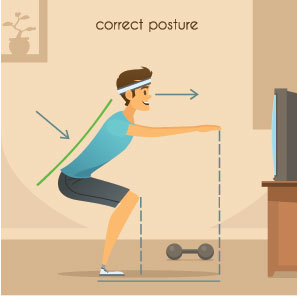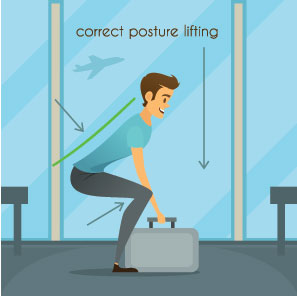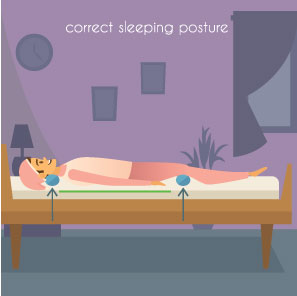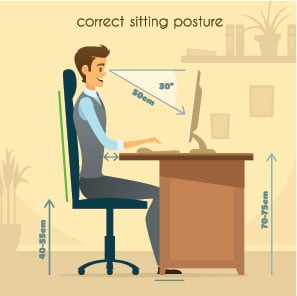The word “ergonomics” is a combination of two Greek words meaning “work” and “laws.” In today’s modern world of varied work industries, ergonomics has evolved to mean the process of adapting work to fit the individual body to avoid physical stress and injury. By designing a work environment that fits a body’s needs instead of requiring the body to fit a predesigned workspace, it’s possible to avoid stress and physical injury. Failure to consider ergonomics may result in undesired pain and injury to people engaged in both work and hobby pursuits.
At the Computer/Desk
 People who spend a lengthy amount of time using a computer at a desk can experience fatigue, physical stress, and injury under some circumstances. You might not realize that just sitting and using a computer for hours each day can cause physical harm to the body. People who do not maintain good posture in a chair or who sit without adequate foot support may experience physical stress over time. Mindfulness about sitting straight, relaxing muscles, positioning equipment to enable comfortable use, and engaging in regular rest periods can help people avoid injuries. It’s also beneficial to create ergonomic
People who spend a lengthy amount of time using a computer at a desk can experience fatigue, physical stress, and injury under some circumstances. You might not realize that just sitting and using a computer for hours each day can cause physical harm to the body. People who do not maintain good posture in a chair or who sit without adequate foot support may experience physical stress over time. Mindfulness about sitting straight, relaxing muscles, positioning equipment to enable comfortable use, and engaging in regular rest periods can help people avoid injuries. It’s also beneficial to create ergonomic
Mindfulness about sitting straight, relaxing muscles, positioning equipment to enable comfortable use, and engaging in regular rest periods can help people avoid injuries. It’s also beneficial to create ergonomic work stations to ensure comfort and health. Chairs should support the entire back in a relaxed position. Adding additional lumbar support may improve chair ergonomics. Computer monitors should be at eye level, approximately an arm’s length away from the body, and tilted to avoid glare. Ergonomic keyboards and peripheral equipment such as a computer mouse can help workers avoid repetitive stress injuries and fatigue.
- Ergonomics at Work
- Easy Ergonomics for Desktop Users (PDF)
- Office Ergonomics (PDF)
- How to Limit Computer Strain on Your Body (PDF)
- Office Ergonomics: Self-Assessment Worksheet (PDF)
- Reducing Occupational Sitting Time and Improving Worker Health: The Take-a-Stand Project
- Ergonomic Tips for Laptop Users (PDF)
Typing
 People who use a computer regularly usually engage in typing to enter information. The process of typing requires the correct position at the computer to avoid stress. Workers should sit in chairs that are the correct height for the computer and keyboard with their feet flat on the floor and shoulders relaxed. Reaching the keyboard should involve elbows bending at least 90 degrees. Achieving this angle may require adjustment of the keyboard tray and chair height.
People who use a computer regularly usually engage in typing to enter information. The process of typing requires the correct position at the computer to avoid stress. Workers should sit in chairs that are the correct height for the computer and keyboard with their feet flat on the floor and shoulders relaxed. Reaching the keyboard should involve elbows bending at least 90 degrees. Achieving this angle may require adjustment of the keyboard tray and chair height.
Failure to design an ergonomic workspace could lead to repetitive stress injuries such as carpal tunnel syndrome, tendonitis, and bursitis.
While Driving
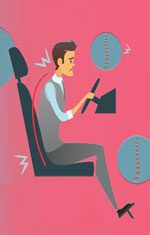 Ergonomics while driving is an important consideration, whether you drive professionally for your job or just for personal needs. While sitting in the driver’s seat, your legs should reach the pedals comfortably without stretching. You should be able to reach the steering wheel without stretching your arms out completely. The driver’s seat should be at the correct height to enable you to easily see over the steering wheel without straining.
Ergonomics while driving is an important consideration, whether you drive professionally for your job or just for personal needs. While sitting in the driver’s seat, your legs should reach the pedals comfortably without stretching. You should be able to reach the steering wheel without stretching your arms out completely. The driver’s seat should be at the correct height to enable you to easily see over the steering wheel without straining.
You can keep pressure off of your lower spine by adjusting the seat so your hips are at 90-degree angle or less. Some drivers add extra lumbar support to the driver’s seat to increase lower back comfort.
It’s also important to take breaks during extended periods of time behind the wheel to change position and stretch the muscles. Frequent breaks help avoid strain and muscle fatigue.
Instruments
Musicians playing various instruments should remain mindful of ergonomics to avoid strain and injury. Some instruments involve playing while standing, while others require the musician to sit while playing. Pay attention to shoulder and arm positioning to ensure comfort. Keep the shoulders aligned with each other, torso straight, and neck aligned with the body. When blowing into an instrument, bring it to the lips instead of vice versa. Remain mindful of breathing while playing to maintain maximum airflow and comfort. When sitting, keep feet firmly on the floor and maintain excellent posture.
An Ounce of Prevention
It’s beneficial to avoid repetitive stress injuries and physical strain rather than having to recover from an injury. Pay attention to how your body feels as you work or engage in any lengthy activity to ensure that you are observing proper body mechanics. Any time you feel strain or fatigue, take a break and stretch. Experts recommend specific parameters for people who engage in any one task involving repetitive motions. Perform the task for 45 minutes and then take a 15-minute break to rest muscles and ease tension.


